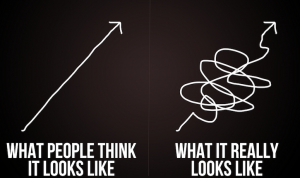There are some definite perks to having a husband like George Couros. He pushes my thinking, asks questions and has high expectations for my teaching and learning. I appreciate all of these qualities immensely and would not be the teacher I am today without his guidance and support. I was talking with him about how I enjoy the idea of Genius Hour and my students really enjoy working on projects like that, but I find that we end up making a bunch of things that eventually get taken home or go in the garbage. I know that the learning is more in the process than in the end product, but I was wanting to try something where the students acquire a skill that they could use for the rest of their life, something they could take with them. My husband, of course, had something for me to watch and told me that he thought I could definitely do this with my kids.
This video is about the 20 hour project. What Josh Kaufman explains is that we can learn a new skill in 20 hours. The way he proposes that we learn this skill is through a few simple steps.
- Deconstruct the Skill (Break the skill down into smaller and smaller pieces- practice the most important skills first).
- Learn Enough to Self-correct ( Get 3-5 resources about what you want to learn. Too many resources and you procrastinate, learn just enough so that you can start and self-correct as you go. Get better at noticing when you make a mistake, and then doing something a little different).
- Remove Practice Barriers (Don’t get caught up in the research phase. Remember that in the end, the point is to actually practice the skill, not just learn how to practice it.)
- Practice at Least 20 Hours
I love that this is a simple premise that can yield some pretty amazing results. There are so many skills that students could learn and so many ways to learn them. YouTube is an amazing resources and has hundreds of experts waiting to assist you. I wanted to try the 20 hour project myself before I got into it with the students so that I could show them my example.
My 20 Hour Project
In high school, I ran cross country and really enjoyed it. I didn’t keep up with it in university and when I started my first year of teaching, I tried to get back into it. The first time I ran, I was so itchy I was dragging myself across the concrete (a ridiculous image, I know). The next time I went running, I was luckily with a friend, the reaction was worse. He had to call an ambulance and take me to the hospital ( my blood pressure was dangerously low and I was passing out, and my whole body was covered in hives). Needless to say, after that I avoided running. Fast forward to almost 7 years later and I finally got my doctor to recommend me to see a specialist. What the specialist concluded was that I have something called “exercise induced anaphylaxis” so basically, I am allergic to running (which no one believes me, so I also asked him for a doctors note). He told me that I would be able to run, if I ran on an empty stomach (hadn’t eaten for 4-5 hours) and took an antihistamine before I went. I was so elated that I could finally run, I rushed to the drugstore and bought some Aerius and started researching. I found 3 resources and an expert who has been running for a long time (my husband) and made a plan. Since I haven’t run in a long time, I started with really short runs and have started working my way up. The first week, I did short 1.5 km runs (because I wanted to stay close to home incase the medication didn’t work). Then, when I realized it was working I started interval training. The first 2 weeks I ran for 2 minutes and walked for 1. Then the third week I ran for 3 and walked for 1. I even started bringing my dogs on the run so that they would push me. The end goal is to be able to run a 10 km in an hour. I am currently only running 4km to get myself used to running and I will continue to increase the distance as I get more comfortable. I am currently running/walking 4km in about 21 minutes, but I know I will get slower as I increase the distance I am running. When I started, it was really tough and I NEEDED that walking time, but as I practice more and more, I feel like I need it less and less. I am really starting to love running. I have also been biking and doing runners yoga to stretch my muscles and help with my performance. So far I am about 5 hours into my project and really liking the idea and the end goal.
As I go through my journey, I have started planning how I can assist my students with their project. I found this resources that has some ideas as to which skills students might choose. Students are definitely not limited to this list, we will also brainstorm ideas and help each other refine our ideas.
One important aspect of this project will be that students do some research. Students will need a mentor to support their journey. They can tweet out asking for help or use YouTube to find an “expert” to support their learning. Students will find 3-5 resources and add them to their 20 hour project google doc. This will allow them to easily find their resources, as well as limit themselves so they don’t procrastinate.
Along with research, we will also need a way to display what we have learned and the process. This way, students can self correct and share with others their progress and ask for support. Students will blog or vlog their progress to illustrate their learning. They must blog each time they work on the project. That might be a few sentences about what they have done that day, their struggles, their success or a video showing progress.
Below is an example of a video of me vlogging my experience. I will continue to document my progress, and ask for support from others as to how to improve my time and how to train smarter. This vlog is only up to day 10, but I will try and update it as I continue to run more and talk about my progress.

